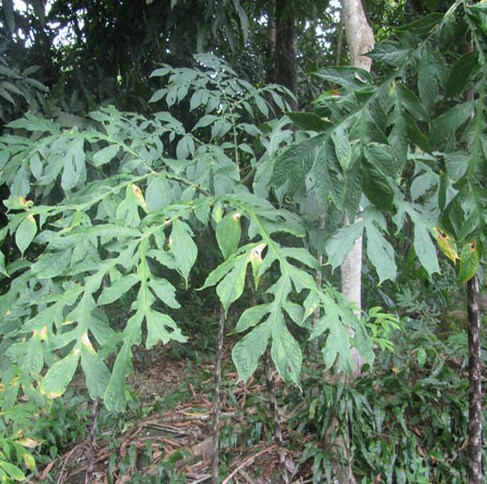Jergon Sacha - Dracontium spruceanum

Common Names: Jergon Sacha, Jergon, Sacha, Sacha Jergon, Fer-de-Lance, Hierba del Jergon, Milho-de-cobra, Taja-de-cobra, Erva Jararaca, Jararaca-Taia, Jararaca, Dracontium, Echidnium, Dracontium spruceanum
Latin Name: Dracontium spruceanum syn. dracontium loretense
Origin: South America, North America
Short Introduction
Rising demand for the Jergon Sacha plant has been driven by increased consumption in Poland, Russia, and other countries throughout Europe and beyond. Presently, thousands of kilograms of the herbal root are harvested annually. Harvesting the rhizome leads to the destruction of the plant, raising concerns over the long-term sustainability of wild collection. Recently, new cultivation methods have been developed, focusing on replanting new specimens immediately after the harvest of mature ones.
Detailed Description
A natural antidote with antiviral potential.
Botanical Information
Jergon Sacha is a large, tropical, perennial understory herb consisting of a single immense divided leaf and typically reaching 1–2 meters in height, though it can grow up to 4 meters. It emerges from a tuber and forms a long, thick stalk that resembles the trunk of a non-woody small tree. During the fertile period, a flowering stalk emerges from the base, growing up to two meters high. At the end of this period, a large reddish-brown spathe (a structure resembling a petal) appears, containing light red-orange, berry-like seeds embedded in the fleshy stem.
Origin and Distribution
Jergon Sacha is a tropical plant found in the understory of the Amazon rainforest. The species occurs in South American countries such as Colombia, Peru, Ecuador, Suriname, and Venezuela, as well as in Latin American countries including Costa Rica, Panama, and others.
Usage / Dosage
The fruit of the Jergon Sacha is edible and is used by local people in cooking. However, its name reflects a traditional belief in its magical ability to repel snakes—a property attributed to it by indigenous communities. The herb is also cultivated as an ornamental plant. Ethnobotanically, Jergon Sacha is a “unique plant”—its firm stalk and spotted coloration are said to resemble venomous snakes native to its region. In Peru and Ecuador, both the snake and the plant share the name Jergon Sacha or fer-de-lance. In Brazil, the names differ: the snake is 'jararaca' and the plant is called 'ervajararaca.'
Ceramides and cerebrosides are essential building blocks in sphingolipid metabolism, mediating both mitogenic and apoptotic responses depending on cell type and biological stimulus. Modern research is exploring pharmaceutical interventions that target these markers for the treatment of cancerous tumors, cardiovascular and neurodegenerative diseases, and in HIV-positive patients. Laboratory analyses utilizing high-sensitivity HPLC with mass spectrometry have detected 21 ceramides—seven newly identified—in Jergon Sacha.
On the Peruvian market, numerous preparations derived from the rhizome or tuber of Jergon Sacha—available as tablets, capsules, and tinctures—can be freely purchased in pharmacies or specialty stores offering natural products. In local medicine, sometimes as a supplement to conventional therapies, these preparations are used for the management of HIV, cancerous tumors, gastrointestinal issues, hernias (topically only), hand tremors, heart palpitations, and in supporting the immune system.
In the 1990s, Peruvian medical journals began to present findings from the Peruvian Institute of Social Welfare regarding the testing and potential application of extracts from several Peruvian plants in the treatment of AIDS. Their research showed that, after six months of regular rhizome extract administration, AIDS patients resumed normal lifestyles; some even tested HIV negative. Other in vitro studies have reported promising findings on the effects of this plant on other viruses, such as Herpes Zoster. Since then, Jergon Sacha's popularity has increased significantly. A 2005 article in the Journal of Ethnopharmacology described its potential antibacterial properties.
Traditional Use
Traditional usage of the plant is largely inspired by its appearance. Indigenous peoples in the Amazon, and other local ethnic groups, use the tuber or rhizome as an antidote for snakebites from local venomous species. In these cases, the tuber is rapidly chopped into small pieces, immersed in cold water, and drunk. Another tuber is chopped, wrapped in a banana leaf, and placed around the bite site. The poultices are changed every 1–2 hours, and the tuber is consumed orally every three to four hours. This method is renowned for its high success rate when administered immediately after the bite—especially in remote areas where access to conventional antivenom is impractical, this generational method developed out of necessity. Other tribes in Guyana utilize the plant as a natural remedy for injuries from stingrays, spider bites, and exposure to poisonous darts or arrows (such as those with curare).
In Brazilian folk medicine, powdered tuber is ingested for recurring asthma attacks, menstrual discomfort with pain, anemia, and various types of cough (including pertussis/whooping cough). Externally, it is applied for scabies; fresh rhizome juice is used for gargling in cases of sore throat with difficulty swallowing and swollen glands. For acute gout attacks, baths are prepared from powdered tuber.
Active Compounds
The entire Jergon Sacha plant contains varying concentrations of alkaloids, saponins, steroids and cyanogenic sterols, xanthones, triterpenes, flavones, flavonoids, simple phenols, anthranones, flavanones, and polysaccharides (starch and its derivatives). Some compounds remain to be specifically identified and quantified.
Traditional Dosage
The standard dose is one heaping tablespoon of chopped tuber soaked in 750 ml of cold water—then brought to a boil and simmered gently for 5–10 minutes. The decoction is consumed in three portions throughout the day. From the rhizome, a tincture may also be prepared; a dose of 3–5 ml (1–2 times daily) is recommended for certain inflammatory oral conditions.
